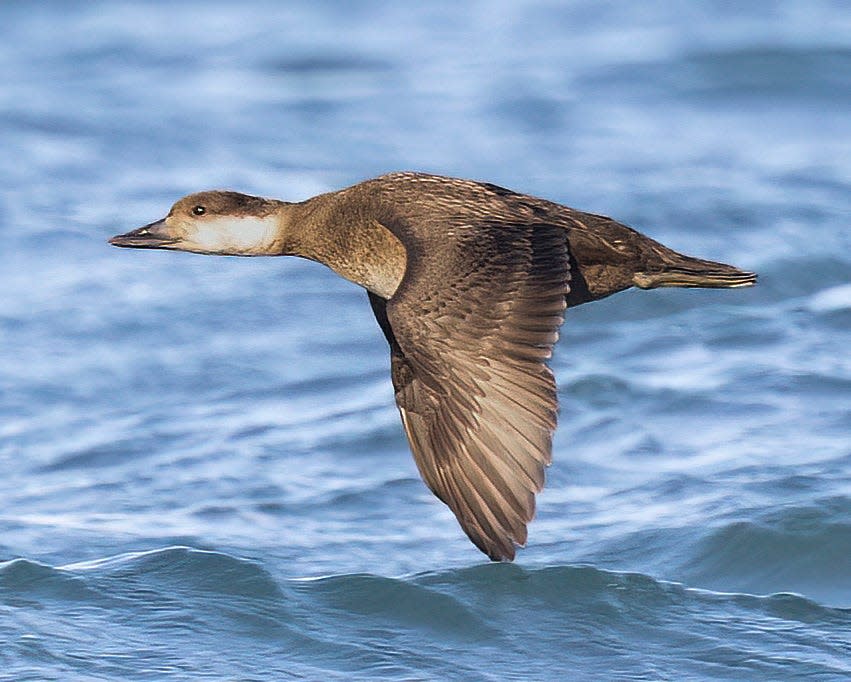Deep-diving scoters, found largely around the Great Lakes, spotted in central Ohio

As a kid growing up in landlocked Worthington, Ohio, sea ducks were the stuff of pipe dreams. Smitten with birds since about the age of 8, but with limited mobility in those earlier years, I read every bird book I could find.
My parents supported my avian infatuation and one of the books they got me was “All the Birds of Eastern and Central North America,” by Richard Pough. This classic guide was published in 1953, at a time when there were few bird guides. When my eyes first met these pages around 1970, there was still precious little bird literature.
Avian aces:Blue jays' love for eating and burying acorns has birthed many a mighty oak tree
Pough spiced his accounts with natural history information, and it was one of few books where I could glean tidbits about how exotic – to me – birds in distant lands lived. His writing transported me to these places, if only in my imagination. I quickly became enamored with sea ducks: eiders, harlequin and long-tailed ducks, and the scoters. (Indeed, for the last two decades my personalized license plate has been “EIDERS.”) Tough, burly sea ducks breed in northern climes and mostly winter on the oceans. Their lives were quite remote from my existence in the flat till plains of central Ohio.
Years later and having now seen scores of all three American scoter species – black, surf, and white-winged – the scoters rank high among my favorites. While this trio regularly transits through the Great Lakes in migration, the Atlantic coast is the place to see the largest numbers in winter. There, big mixed flocks form, looking like small storm clouds as they fly low over the water. Mussels are a winter dietary staple and there are plenty of those in salty waters.
Scoter spotting
In Ohio, all three scoters occur regularly, just in far smaller numbers than on oceanic haunts. Lake Erie is by far the best locale and late fall and early winter is the best time. While occasional small flocks occur, more often it is single birds or perhaps a handful. On a recent boat trip out of Lorain Harbor, our group saw one black scoter; its image accompanies this column.
Scoter numbers spike dramatically just 100 miles east of Ohio’s Lake Erie waters, in Lake Ontario. Between Hamilton and Toronto, Ontario, big numbers of all three scoters and their relative, the long-tailed duck, occur in winter. There, one can hear the clangorous yowls, grunts and whistles of large packs of birds. Lake Ontario averages 183 feet deep – Lake Erie is only 63 feet deep on average – and the hardy sea ducks prefer deeper, colder waters. Long-tailed ducks can dive to over 200 feet, and white-winged scoters nearly as deep. All the scoters can forage at depths exceeding Lake Erie’s average depth.
Winged singers:Distinctive singers, a variety of tiny wrens found in Ohio boast bold voices
Migrant scoter numbers have increased in Lake Erie in the last three decades, and an invasive clam is probably responsible. In 1988, the first zebra mussel was found and their numbers, augmented by non-native quagga mussels, have skyrocketed. While scoters probably eat these Asiatic invaders with a passion and have partially shifted migratory pathways to exploit this food source, there are not enough ducks to make a dent in the mussels’ population.
Black scoter is the most commonly seen scoter on Lake Erie, and occasionally flocks of dozens occur. The surf scoter is next most common, with the white-winged scoter a distant third. Unfortunately, we rarely get adult male scoters, with their coal-black plumage and gaudy bill and head markings. Male black scoters look like they have a lump of orange butter stuck to their bills. Surf scoters are nicknamed “skunk-head” due to the males’ bold white head markings, and they sport a parti-colored orange, yellow, black and white bill. A bold white comma flares from the white-winged scoter’s eye, and its knobbed bill is a peachy red.
Central Ohio is occasionally graced with the presence of scoters. In recent weeks, a black scoter appeared on Watermark Quarry near Grandview. And a few black and surf scoters have been seen on Alum Creek Reservoir.
Naturalist Jim McCormac writes a column for The Dispatch on the first, third and fifth Sundays of the month. He also writes about nature at www.jimmccormac.blogspot.com.
This article originally appeared on The Columbus Dispatch: Nature: Black and surf scoters spotted recently in central Ohio waters

